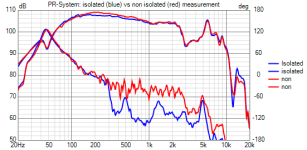Folks, first of all I'm not a fan of reflex loaded woofers, but lately I've noticed invasion of PRs in hifi-speakers, like Amphion Two18 and many 2-ways with Purifi woofer. Subwoofers are very simple cases because of low-pass at 80-120Hz.
Small box and low tuned passive radiator is theoretically easier to make than a reflex port. Many easy online calculators can give port dimensions so most DIYers use them. The port easily chuffs and leaks midrange frequencies in opposite polarity, making sounds that can be heard and measured.
Passive radiator(s) are easy to fit on the backside of the box and they don't eat box volume. Listening impressions are good, but I have failed to find nearfield measurements that can show obvious resonances and "leakage" of midrange. The PR has wide membrane, so that's strange regarding pursuit for rigid non-resonating encloseres...
Below my measurements of my subwoofer running without xo, Peerless XLS10 and respective PR. Drivers are side-by side, so nearfield measurement of the PR is not "clean". I don't have now time to make a test box with opposing placement, so I ask help from fellow diyers. I have taken also some distortion plots with sine at tuning freq, but I couldn't find them now.
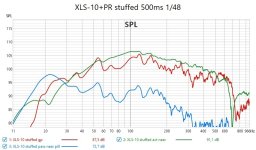
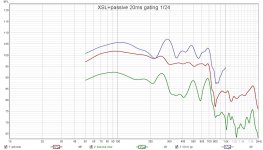
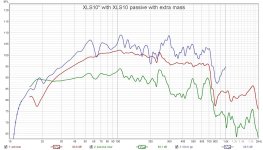
Small box and low tuned passive radiator is theoretically easier to make than a reflex port. Many easy online calculators can give port dimensions so most DIYers use them. The port easily chuffs and leaks midrange frequencies in opposite polarity, making sounds that can be heard and measured.
Passive radiator(s) are easy to fit on the backside of the box and they don't eat box volume. Listening impressions are good, but I have failed to find nearfield measurements that can show obvious resonances and "leakage" of midrange. The PR has wide membrane, so that's strange regarding pursuit for rigid non-resonating encloseres...
Below my measurements of my subwoofer running without xo, Peerless XLS10 and respective PR. Drivers are side-by side, so nearfield measurement of the PR is not "clean". I don't have now time to make a test box with opposing placement, so I ask help from fellow diyers. I have taken also some distortion plots with sine at tuning freq, but I couldn't find them now.



Can't read out what you want help with...
Simulation a suitable cabinet and selecting passive radiator?
Simulation a suitable cabinet and selecting passive radiator?
I am about to make my PR test-speaker. I will test it isolating active and passive radiators as much as possible.
OK.
Have a pair of old Thiel 3.6 still around that I can measure if you like.
https://tmraudio.com/speakers/floor...-floorstanding-speakers-cs3-6-amberwood-pair/
Both PR and bass driver close and on front, so might not be in line with your idea of design.
The PR cone is not a traditional driver cone, but a hexagrid plate that might mask resonanses more than a cone would.
Let me know if a nearfield measurement will be of use for you.
Have a pair of old Thiel 3.6 still around that I can measure if you like.
https://tmraudio.com/speakers/floor...-floorstanding-speakers-cs3-6-amberwood-pair/
Both PR and bass driver close and on front, so might not be in line with your idea of design.
The PR cone is not a traditional driver cone, but a hexagrid plate that might mask resonanses more than a cone would.
Let me know if a nearfield measurement will be of use for you.
Last edited:
No matter what you've used as membrane for the PR but for the midrange garbage every PR will perform better than a port in that regard. If you have trouble to measure what's going on, just hold/press it on the baffle a board between the driver and the PR while measuring the midrange.
As long as your nearflield measurement is really nearfield (like 0.25" from the passive's cone), I think the distance will swamp out everything else to a reasonable degree.
https://www.stereophile.com/content/thiel-cs6-loudspeaker-measurements

https://www.stereophile.com/content/goldenear-brx-bookshelf-reference-x-loudspeaker-measurements

https://www.stereophile.com/content...ncore-powered-loudspeaker-system-measurements

Text below the plot says "port", but it's a passive radiator
https://www.stereophile.com/content/klipsch-forte-iii-loudspeaker-measurements

looking for real measured data
https://www.stereophile.com/content/thiel-cs6-loudspeaker-measurements
https://www.stereophile.com/content/goldenear-brx-bookshelf-reference-x-loudspeaker-measurements
https://www.stereophile.com/content...ncore-powered-loudspeaker-system-measurements
Text below the plot says "port", but it's a passive radiator
https://www.stereophile.com/content/klipsch-forte-iii-loudspeaker-measurements
Last edited:
And same issue on the Stereophile Vanatoo text - says "port" under the graph, but it's a passive radiator also.
Thank you ente! Excellent test, more these comparisons!
PR has more Sd than a port, so anechoic 3D measurements (or Klippel NFS) would tell more about system performance.

PR has more Sd than a port, so anechoic 3D measurements (or Klippel NFS) would tell more about system performance.
For comparison, here is a set of near field measurements I made just a few days ago.
https://www.diyaudio.com/community/...ivers-a-new-3-way-project.413182/post-7762790
I am using a Dayton RS225-8 woofer in a 42 liter (net) volume, with a Dayton DS270-PR Passive Radiator. Both the woofer and the PR face forward, and they are physically close together. There is a 3 inch thick layer of foam on the rear cabinet wall, and this fills about 40% of the volume.

In my thread, I show the response up to 1k, but here I show it out to 10k. The null at 1.5k is the cancellation null that happens during nearfield measurements. When I measure the PR nearfield, the woofer is fairly close, so I can not know how much direct woofer response is being picked up by the nearfield PR mic... probably a lot.
https://www.diyaudio.com/community/...ivers-a-new-3-way-project.413182/post-7762790
I am using a Dayton RS225-8 woofer in a 42 liter (net) volume, with a Dayton DS270-PR Passive Radiator. Both the woofer and the PR face forward, and they are physically close together. There is a 3 inch thick layer of foam on the rear cabinet wall, and this fills about 40% of the volume.
In my thread, I show the response up to 1k, but here I show it out to 10k. The null at 1.5k is the cancellation null that happens during nearfield measurements. When I measure the PR nearfield, the woofer is fairly close, so I can not know how much direct woofer response is being picked up by the nearfield PR mic... probably a lot.
Here is a first measurement of one peerless SDS-100F25CP09-4 woofer and two peerless SDS-P830880 radiators installed in a 6.5 liter enclosure.
there is some eggcrate foam in the enclosure that I might remove for the next measurement just to test how much resonances are transmitted via the PRs.
It's interesting that the peerless PRs have a very heavy iron weigth glued in place of a voice coil that reduces their flexibility quite a lot.
The PRs have a total MMS of 48 g (per spec sheet) of which according to my calculations nearly 30 g are the iron weight.
In order to get a somewhat sensible tuning for the 4" SDS-100 woofer I had to install two 5.25" PRs.
The speaker has the active and passive drivers installed on opposite sides and I put it into a pass-through between my kitchen and dining room, stuffing the remaining opening with pillows and blankets:
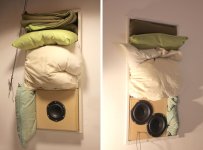
here are the measured nearfield (~ 5 mm distance) responses:
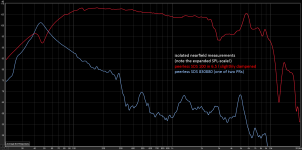
The response of the other PR was nearly identical, but slightly lower in output (-1,5 dB). That might have been an inaccuracy when positioning the mic.
just for comparison, here is a nearfield measurement of the same speaker (active driver + PR), but not isolated by installation into the wall pass-through, just placing the speaker in the room:

Interestingly the PR datasheet includes a response graph that very slightly resembles what i have measured in the isolated version:
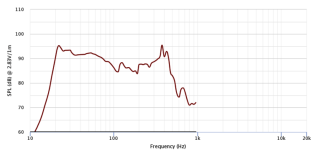
there seem to be some resonances around 400 Hz and a quite steep rolloff above. In my measurement the rolloff already starts at 300 Hz.
there is some eggcrate foam in the enclosure that I might remove for the next measurement just to test how much resonances are transmitted via the PRs.
It's interesting that the peerless PRs have a very heavy iron weigth glued in place of a voice coil that reduces their flexibility quite a lot.
The PRs have a total MMS of 48 g (per spec sheet) of which according to my calculations nearly 30 g are the iron weight.
In order to get a somewhat sensible tuning for the 4" SDS-100 woofer I had to install two 5.25" PRs.
The speaker has the active and passive drivers installed on opposite sides and I put it into a pass-through between my kitchen and dining room, stuffing the remaining opening with pillows and blankets:

here are the measured nearfield (~ 5 mm distance) responses:

The response of the other PR was nearly identical, but slightly lower in output (-1,5 dB). That might have been an inaccuracy when positioning the mic.
just for comparison, here is a nearfield measurement of the same speaker (active driver + PR), but not isolated by installation into the wall pass-through, just placing the speaker in the room:

Interestingly the PR datasheet includes a response graph that very slightly resembles what i have measured in the isolated version:

there seem to be some resonances around 400 Hz and a quite steep rolloff above. In my measurement the rolloff already starts at 300 Hz.
Last edited:
I did some tone burst measurements of PR systems years ago……sadly I don’t have that data to share anymore. I can only add why I personally abandoned PR use where the nasty resonances i was seeing in relation to the enclosure dimensions and what i assumed to be standing waves. I used a Fender P Bass and played notes from low C on up and when the note hit the resonance, it was horrible……gave up on em right then and there.
After trying a bunch of Fender P-Bass and finding the notes sounding inconsistent in level, I gave up on them and bought a Yamaha RBX-260 Bass 😉I used a Fender P Bass and played notes from low C on up and when the note hit the resonance, it was horrible……gave up on em right then and there.
Wish I hadn't sold my RBX-260 and Mackie HRS120 passive radiator sub...
Art
Interesting 12", do you feel it may be of use to me? Is the flat to 20Hz mentioned in the review eq assisted? Have you thought to build something even better than that?Wish I hadn't sold my RBX-260 and Mackie HRS120 passive radiator sub...
https://liquidaudio.com.au/awesome-mackie-hrs120-subwoofer-review/
Here is a first measurement of one peerless SDS-100F25CP09-4 woofer and two peerless SDS-P830880 radiators installed in a 6.5 liter enclosure.
there is some eggcrate foam in the enclosure that I might remove for the next measurement just to test how much resonances are transmitted via the PRs.
It's interesting that the peerless PRs have a very heavy iron weigth glued in place of a voice coil that reduces their flexibility quite a lot.
The PRs have a total MMS of 48 g (per spec sheet) of which according to my calculations nearly 30 g are the iron weight.
In order to get a somewhat sensible tuning for the 4" SDS-100 woofer I had to install two 5.25" PRs.
The speaker has the active and passive drivers installed on opposite sides and I put it into a pass-through between my kitchen and dining room, stuffing the remaining opening with pillows and blankets:
View attachment 1345295
here are the measured nearfield (~ 5 mm distance) responses:
View attachment 1345296
The response of the other PR was nearly identical, but slightly lower in output (-1,5 dB). That might have been an inaccuracy when positioning the mic.
just for comparison, here is a nearfield measurement of the same speaker (active driver + PR), but not isolated by installation into the wall pass-through, just placing the speaker in the room:
View attachment 1345305
What can we say about these measurements? Is the conclusion that midrange/ Port resonances do not actually exist, but they are a measurement artefact of the mic being too close to the port/PR/driver?
I would not conclude that - not at all.Port resonances do not actually exist
My measurement just shows that PRs have a characteristic response that is better (or only) visible when isolating the measurement.
I will post some more measurements next, one without damping material in the enclosure to see whether and how much the PR transmit enclosure resonances. And another one with an (optimized) port as comparison. There will surely be a port length resonance, but eventually I will include a respective absorber.
I wouldn't say that the PR doesn't let any sound through. That's easy to see in my example (post #10).
@stv
I've put your measurements together in one picture. That way you can see the differences better.
It would be nice if you could repeat the measurements again without damping.
Regards
Heinrich
@stv
I've put your measurements together in one picture. That way you can see the differences better.
It would be nice if you could repeat the measurements again without damping.
Regards
Heinrich
Attachments
Thank you very much, Heinrich!That way you can see the differences better
Responses without dampening material
please note that I have adjusted the relative output level of PRs according to their diaphragm areas - relative outputs are now correctly related, but not at absolute (1W/2,83V @1m) levels!
The isolated responses, but now including both passive radiators:
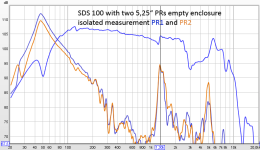
The resonances at 1,3 kHz (at -18 dB from tuning peak) and 5 kHz (around - 24 dB) are very evident.
It's also interesting to see that the PR's outputs are not identical (it's not a measurement inaccuracy!) - one has more output and the other one shows a wiggle at 25 Hz (following the specs at meniscus audio that's the free air resonance of the PR). maybe the suspension stiffness is not identical.
The 1.3 kHz resonance is probably related to the enclosure width (roughly the diaphragm to back wall, about 13 cm).
the 5 kHz resonance does not appear in the active driver response. It's also quite independent from the enclosure dampening so I assume it's a diaphram/suspension resonance. but of course it's far outside the useful woofer passband.
for reference, here is a hornresp simulation with enclosure length 13,1 cm, with a similar 1,3 kHz peak at the PR output:

Here is a comparison of dampened/non-dampened outputs:

here I do suspect that the level difference of active driver is a microphone distance difference.
The dampening material slightly increases the apparent enclosure volume and lowers the tuning.
of course the dampening material reduces the 1,3 kHz enclosure resonance significantly by ~15 dB. The 5 kHz (driver resonance?) peak is just slightly lower.
Comparison of isolated and non-isolated measurement responses:
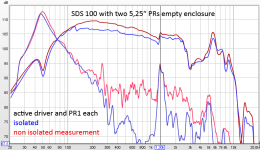
again, as with the dampened enclosure the non-isolated PR response seems to be swamped in bleeded-over output from the active driver.
there are more differences, however:
the "isolated" setup is a real 2pi "in-wall" speaker situation. maybe that explains the SPL differences between 120 and 2 kHz - but I am really not sure about it.
The small peak at 124 Hz may be related to the distance of speaker(s) to the floor and the ceiling ( around 130 cm each). The speaker was just about 50 cm above the floor for the "non-isolated" measurement.
The 2pi seems to have a slightly lower tuning,
let me know if you would like to see any other comparison graphs!
(vented versions will come next. I just have to print vents and make an adapter board!)
Last edited:
I should add, and it might be quite relevant, the "isolated" measurement includes some 3 additional meters of (cheap) speaker cable, about 0,5 ohms of added resistance!maybe that explains the SPL differences between 120 and 2 kHz - but I am really not sure about it.
- Home
- Loudspeakers
- Multi-Way
- Passive reflex radiator nearfield measurements
